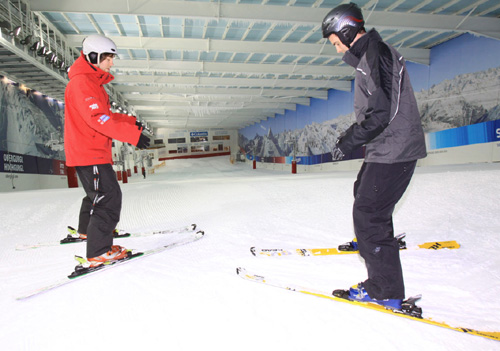In a previous post, I have looked at how to become a ski instructor through Gap Year courses.
A gap year course is a fast track way to become a qualified instructor, often to the first level that is required to teach children or beginners. From there, attainment of further qualifications will enable the ski teacher to further their career, increase their salary and teach skiing at higher levels.
In this post, I intend to focus on the options that skiers, from the UK, have when deciding how to become a ski instructor.
The main route for ski instructor qualification, in the UK, is though BASI (British Association of Snowsport Instructors). Recently, BASI have introduced a new structure to their qualifications by introducing a new entry level which is based both in the Alps or on indoor snow slopes in the UK, which there are now several around the country. This qualification provides instructors with a licence to teach on artificial slopes and indoor snow slopes, and is also a great launch pad into the BASI system.
The level 1 course is 5 days long. From here, it is necessary to gain some experience of teaching before embarking on the level 2 course (10 days) which are held either in Scotland or the Alps. This teaching experience can be done at an artificial or indoor snow slope in the UK. Once level 2 has been achieved, then you will be able to teach skiing on marked pistes up to intermediate level (providing that you are within the legal parameters of the county and/or local region).
The main thing (to become a ski instructor) is to get out there on an artificial slope, indoor snow slope or the mountains and ski as much as possible. Teaching a sport such as skiing also involves a high level of responsibility and starting to think about your environment and fellow skiers is a crucial part of being a ski instructor.
One way is to start teaching and gaining valuable experience on artificial ski slopes.
The UK has a great tradition and history with the sport of skiing especially considering the limited options available in terms of skiing facilities.
In the 1980’s the sport expanded into one of the fastest growing in the country and artificial slopes opened up in every region. This gave young people who previously had no access to the mountains a chance to learn to ski and become involved in teaching on their local slope. Governing bodies started up to implement and train instructors specifically for teaching on artificial slopes. In England, this was administered by ‘The English Ski Council’, now Snowsport England, which along with Snowsport Scotland and Snowsport Wales trains instructors specifically for artificial slopes.
Teaching skiing on artificial slopes requires the same skills as teaching on snow. It is also often more intensive as you don’t spend so much time on ski lifts and within a one hour lesson you are actively teaching for a high proportion of the time.
View our list of Skiing Centres in the UK.
Another option is to work a season in a Scottish Ski Resort.
The Scottish ski resorts sometimes get bad publicity. Stories of no snow or freezing rain can be off putting for people. There is no doubt that the conditions can sometimes be difficult, but on a good day the skiing is great and certainly for an instructor embarking on a career it can be an excellent launching pad. The largest centres are the Cairngorm Mountain, near Aveimore and the Nevis Range, near Fort William.
Once some experience and these first qualifications are gained then deciding to take the next step and become a fully qualified ski teacher should not be taken lightly. To continue with a career in Snowsports instruction means that a higher level of qualification is essential. This enables you to teach to higher levels and on varying terrain. Also, some ‘Alpine’ countries require the highest level of qualification to teach at any level.
